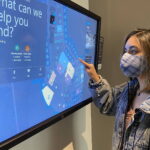 It’s been a privilege to help drive Microsoft’s real estate transformation.
It’s been a privilege to help drive Microsoft’s real estate transformation.
As an IT leader at Microsoft, I appreciate the powerful transformation acceleration that comes from partnering closely with the internal business partner that you support. I work in Microsoft Digital, the organization that powers, protects, and transforms Microsoft, and I partner with the Microsoft Real Estate team who manages our buildings and facilities.
My team works hand in hand with the Real Estate team to develop, deliver, and roll out technology solutions to improve the experience our employees have across the globe with our 600-plus buildings and their amenities. We also build solutions that enable our Real Estate team to run their portfolio more efficiently. Our partnership has been pivotal in moving from simply building IT solutions to digitally transforming real estate at Microsoft.
Typically, technology is added to a building many years or even decades after building construction. For example, software for booking a conference room or reserving a campus shuttle is developed independently from the office building being built, bought, or leased. This model works OK. However, to truly transform, technology needs to be integrated into the building, which requires a tight real estate and IT partnership.
Microsoft’s journey
Our journey started about seven years ago when we kicked off a classic “add-on” model for new technology that our Real Estate team could use to transform their operations. We successfully developed three add-on technologies:
- A corporate real estate Microsoft Azure Data Warehouse to improve real estate and financial decision-making.
- A lobby portal for fast and easy visitor check-in.
- A one-stop application for employee shuttle and bus reservations.
These projects solved immediate pain points and started our team’s partnership.
As our partnership matured and trust deepened, we moved to the next level of more transformative technology. For example, we built a Microsoft Dynamics 365 tool to manage all aspects of global facilities management. Another project applied machine learning to optimize our building footprints based on occupancy data. Finally, we built a dining order-ahead capability for our cafeterias at our headquarters campuses in Washington state.
In order to take our technology to the next level, we started to integrate technology into buildings through the use of IoT sensors and Microsoft Azure Digital Twins. Microsoft’s newest buildings—rolling out at our headquarters campus and at locations all around the world—will have more than 4,000 IoT sensors incorporated into each building! These sensors enable digital transformation of employee experiences and building management, including sensors to detect cafeteria crowdedness, wayfinding beacons to help employees navigate our campuses, and enhanced parking solutions to solve the age-old “find a parking spot” problem.
Through Microsoft Azure Digital Twins, we have created a digital replica of our physical building infrastructure. This allows Microsoft’s Real Estate team to better run the campus and create amazing experiences.
To achieve digital transformation, we need complete building and technology integration, including the building’s infrastructure such as segmented networks. This transformation is easier to accomplish with a greenfield site; however, our long-term goal is to transform our existing sites as well.
How to build a real estate and IT partnership
We have found the following to be critical to building our partnership:
- Understanding each other’s worlds. One of the hardest challenges we faced was figuring out how to overlay technology onto a construction schedule. We discovered the hard way that construction doesn’t wait, and once a building’s walls and ceilings are installed, our technological choices are severely more limited. Now, when we approach a new site, our teams work together to understand each other’s schedules and lead times. We also work with each new site to understand their priorities. For some sites, Microsoft is the owner; for other sites, we’re an occupant. The setup, usage, and occupants of each site determine priorities and the balance of employee-facing versus facility-management technologies. We’ve gotten better at doing a site-by-site assessment instead of assuming “one size fits all.”
- Have shared goals. Our joint Real Estate and IT teams share goals in several ways. We have joint “north star” visions for our employee experiences that have guided nearly every prioritization decision that we made. Furthermore, we rallied around a set of priority new construction buildings around the globe. These shared priorities help our teams be laser-focused, which is much easier said than done in an innovation space where there are many new technologies and inventions that we “could” incorporate.
- Squads for each vertical. Our project is vast, encompassing transportation, dining, productivity, access, and facility operations. Within these verticals, we have what we call “squads,” which include our engineering leads, user experience leads, and the Real Estate team lead. These squad leads focus on goals, blockers, and prioritization. This setup of joint ownership at all levels enables every part of our large team to run fast.
All these partnership aspects helped tremendously when our north star goals were pressure-tested by the COVID-19 epidemic. We needed to be nimble in our plans so that we could help ensure a safe return to the office when sites become ready. If we hadn’t already had the partnership and trust in place, our real estate technology COVID response would have been slower and lower-tech. Post-pandemic, our partnership is helping us determine what the future of hybrid will mean for real estate technology.
I’m very proud to be part of the Real Estate and IT partnership that is digitally transforming Microsoft’s physical buildings.








